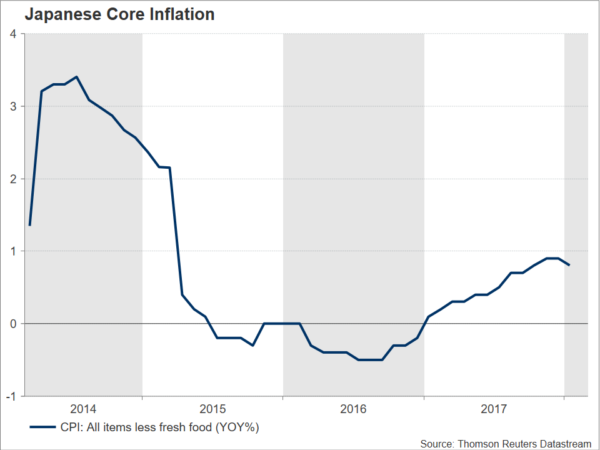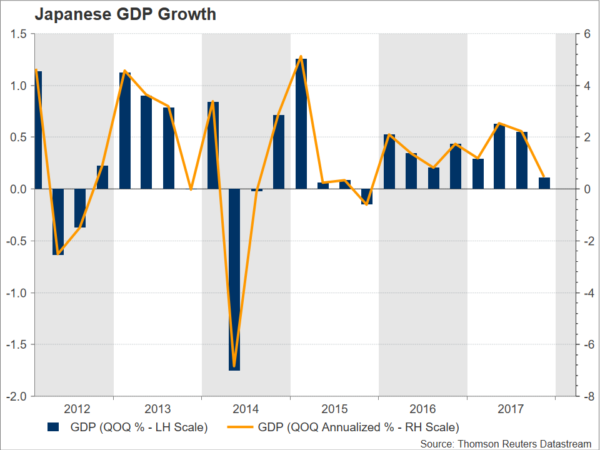The Bank of Japan will be concluding its meeting on monetary policy on Friday, with a decision on rates being made public at 0400 GMT. Markets project the Bank to maintain its ultra-easy monetary policies firmly in place. However, despite no change being expected, the meeting is gathering more attention than past ones on the back of mounting speculation that the Japanese central bank is preparing the ground for an exit from ultra-loose policies, something which has allowed the yen to post notable gains relative to other majors so far in 2018.
Japan’s central bank is anticipated to keep its short-term interest rate unchanged at -0.1% and continue to target the yield of 10-year Japanese government bonds with the scope of maintaining it around 0% in the face of core inflation – the measure that includes oil products but excludes volatile fresh food items and which is targeted by the Japanese central bank – well undershooting the Bank’s annual target of 2%.
 Ever-growing expectations that the BoJ is paving the way for policy normalization have been one of the main drivers behind the yen’s year-to-date appreciation by around 6% versus the US currency. Last Friday, dollar/yen hit a 16-month low of 105.23 as BoJ Governor Haruhiko Kuroda said that the Bank will start thinking about how to exit its ultra-loose monetary policy stance around the fiscal year starting in April 2019.
Ever-growing expectations that the BoJ is paving the way for policy normalization have been one of the main drivers behind the yen’s year-to-date appreciation by around 6% versus the US currency. Last Friday, dollar/yen hit a 16-month low of 105.23 as BoJ Governor Haruhiko Kuroda said that the Bank will start thinking about how to exit its ultra-loose monetary policy stance around the fiscal year starting in April 2019.
Despite Kuroda saying that stimulus withdrawal is dependent on the inflation target being met – something which might allow someone to argue that nothing essentially new was said – still it didn’t stop the markets from placing long yen positions. Also, on Tuesday, there was limited reaction to comments by Kuroda, who clarified what he meant last Friday by saying that in fiscal 2019, the BoJ “would be discussing how to move forward with exit [from monetary easing]” and adding “I never said we would be exiting immediately in fiscal 2019″. All these might mean that markets are anchoring towards a BoJ normalization narrative, being much more willing to buy the yen on hawkish-perceived comments than sell it on remarks on the other side of the spectrum. This might present opportunities for savvy investors. However, it should be kept in mind that besides monetary policy there are other currency drivers and it might be those that are supporting a stronger yen at the moment – for example, some fear that Trump’s trade rhetoric could backfire, weighing on the US’ growth outlook, and this is one factor acting to the detriment of the greenback.
Turning back to the upcoming meeting, a press conference by Governor Kuroda will follow the Bank’s rate decision. His comments and the Bank’s views on the outlook for growth and inflation have the capacity to lead to movements in yen pairs.
Focusing on dollar/yen, should views that the BoJ is getting closer to normalizing policy receive a boost, then the pair is expected to record losses. In this case, support could come around last week’s 16-month low of 105.23, with sharper declines shifting the focus to the area around 103 which was relatively congested back in 2016. If on the other hand the BoJ decisively shuts the door on tightening coming any time soon, the pair might head higher. The range around 107, which also encapsulates a bottom from the recent past, might act as a barrier to the upside. Further above, the area around 109 was congested recently and may be of significance.
 In terms of data out of the world’s third largest economy, revised Q4 2017 GDP figures will be made public on Wednesday at 2350 GMT. The growth rate is anticipated to be revised to 0.9% on an annualized basis from the preliminary reading of 0.5%; this compares to Q3’s respective reading of 2.2%. The projected upward revision is expected to have come on the back of a stronger than previously recorded capex contribution, as corporations accelerated their investments in plant and equipment during the last quarter of 2017. Quarter-on-quarter, analysts project growth to stand at 0.2% in Q4. The Japanese economy posting positive growth in Q4 constitutes the eighth straight quarter of uninterrupted expansion, this being the longest such stretch since a period between 1986-1989 when the economy grew for 12 consecutive quarters and which was later linked to a bubble. Wednesday’s growth numbers also have the potential to lead to positioning on the yen. (GDP figures for Q4 2017 in the chart below correspond to the preliminary release.)
In terms of data out of the world’s third largest economy, revised Q4 2017 GDP figures will be made public on Wednesday at 2350 GMT. The growth rate is anticipated to be revised to 0.9% on an annualized basis from the preliminary reading of 0.5%; this compares to Q3’s respective reading of 2.2%. The projected upward revision is expected to have come on the back of a stronger than previously recorded capex contribution, as corporations accelerated their investments in plant and equipment during the last quarter of 2017. Quarter-on-quarter, analysts project growth to stand at 0.2% in Q4. The Japanese economy posting positive growth in Q4 constitutes the eighth straight quarter of uninterrupted expansion, this being the longest such stretch since a period between 1986-1989 when the economy grew for 12 consecutive quarters and which was later linked to a bubble. Wednesday’s growth numbers also have the potential to lead to positioning on the yen. (GDP figures for Q4 2017 in the chart below correspond to the preliminary release.)
 Data on January’s current account surplus will be released alongside Wednesday’s GDP numbers, while household spending figures for the month of January will go public on Thursday at 2350 GMT. These will also be attracting interest.
Data on January’s current account surplus will be released alongside Wednesday’s GDP numbers, while household spending figures for the month of January will go public on Thursday at 2350 GMT. These will also be attracting interest.
Lastly, it should be noted that the currency – a perceived safe-haven – could receive flows should trade tensions following the Trump administration’s decision to impose tariffs on imported steel and aluminum escalate. However, one should keep in mind that if Japan, a major exporting power, is seen as losing out from developments on trade, then safe-haven flows might instead be diverted to other assets, such as gold.











